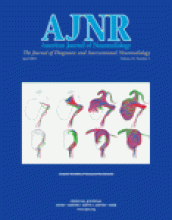Research ArticleBrain
Quantitative Assessment of the Time Course of Infarct Signal Intensity on Diffusion-Weighted Images
James D. Eastwood, Stefan T. Engelter, James F. MacFall, David M. Delong and James M. Provenzale
American Journal of Neuroradiology April 2003, 24 (4) 680-687;
James D. Eastwood
Stefan T. Engelter
James F. MacFall
David M. Delong

References
- ↵Warach S, Chien D, Li W, Ronthal M, Edelman RR. Fast magnetic resonance diffusion-weighted imaging of acute human stroke. Neurology 1992;42:1717–1723
- Warach S, Gaa J, Siewert B, Wielopolski P, Edelman RR. Acute human stroke studied by whole brain echo planar diffusion-weighted magnetic resonance imaging. Ann Neurol 1995;37:231–241
- ↵Schlaug G, Siewert B, Benfield A, Edelman RR, Warach S. Time course of the apparent diffusion coefficient (ADC) abnormality in human stroke. Neurology 1997;49:113–119
- ↵Bastin ME, Rana AK, Wardlaw JM, Armitage PA, Keir SL. A study of the apparent diffusion coefficient of grey and white matter in human ischemic stroke. Neuroreport 2000;11:2867–2874
- Desmond PM, Lovell AC, Rawlinson AA, et al. The value of apparent diffusion coefficient maps in early cerebral ischemia. AJNR Am J Neuroradiol 2001;22:1260–1267
- ↵Lutsep HL, Albers GW, DeCrespigny A, Kamat GN, Marks MP, Moseley ME. Clinical utility of diffusion-weighted magnetic resonance imaging in the assessment of ischemic stroke. Ann Neurol 1997;41:574–580
- ↵Marks MP, de Crespigny A, Lentz D, Enzmann DR, Albers GW, Moseley ME. Acute and chronic stroke: navigated spin-echo diffusion-weighted MR imaging [published correction appears in Radiology 1996;200:289]. Radiology 1996;199:403–408
- ↵Yang Q, Tress BM, Barber PA, et al. Serial study of apparent diffusion coefficient and anisotropy in patients with acute stroke. Stroke 1999;30:2382–2390
- ↵Lansberg MG, Thijs VN, O’Brien MW, et al. Evolution of apparent diffusion coefficient, diffusion-weighted, and T2-weighted signal intensity of acute stroke. AJNR Am J Neuroradiol 2001;22:637–644
- ↵Engelter ST, Provenzale JM, Petrella JR, Alberts MJ, DeLong DM, MacFall JR. Use of exponential diffusion imaging to determine the age of ischemic infarcts. J Neuroimaging 2001;11:141–147
- ↵Burdette JH, Ricci PE, Petitti N, Elster AD. Cerebral infarction: time course of signal intensity changes on diffusion weighted images. AJR Am J Roentgenol 1998;171:791–795
- ↵Burdette JH, Elster AD, Ricci PE. Acute cerebral infarction: quantification of spin-density and T2 shine-through phenomena on diffusion-weighted MR images. Radiology 1999;212:333–339
- ↵Knight RA, Dereski MO, Helpern JA, Ordidge RJ, Chopp M. Magnetic resonance imaging assessment of evolving focal cerebral ischemia: comparison with histopathology in rats. Stroke 1994;25:1252–1262
- ↵Provenzale JM, Engelter ST, Petrella JR, Smith JS, MacFall JR Use of MR exponential diffusion-weighted images to eradicate T2 “shine-through” effect. AJR Am J Roentgenol 1999;172:537–539
- ↵Copen WA, Schwamm LH, Gonzalez RG, et al. Ischemic stroke: effects of etiology and patient age on time course of the core apparent diffusion coefficient. Radiology 2001;221:27–34
- ↵Huang IJ, Chen CY, Chung HW, et al. Time course of cerebral infarction in the middle cerebral arterial territory: deep watershed versus territorial subtypes on diffusion-weighted MR images. Radiology 2001;221:35–42
- ↵Schwamm LH, Koroshetz WJ, Sorensen AG, et al. Time course of lesion development in patients with acute stroke: serial diffusion- and hemodynamic-weighted magnetic resonance imaging. Stroke 1998;29:2268–2276
- ↵Adams HPJ, Bendixen BH, Kappelle LJ, et al. Classification of subtype of acute ischemic stroke: definitions for use in a multicenter clinical trial. TOAST—Trial of Org 10172 in Acute Stroke Treatment. Stroke 1993;24:35–41
- ↵Falconer JC, Narayana PA. Cerebrospinal fluid-suppressed high-resolution diffusion imaging of human brain. Magn Reson Med 1997;37:119–123
- ↵Hankey GJ. Stroke: how large a public problem and how can the neurologist help? Arch Neurol 1999;56:748–754
In this issue
Advertisement
James D. Eastwood, Stefan T. Engelter, James F. MacFall, David M. Delong, James M. Provenzale
Quantitative Assessment of the Time Course of Infarct Signal Intensity on Diffusion-Weighted Images
American Journal of Neuroradiology Apr 2003, 24 (4) 680-687;
0 Responses
Jump to section
Related Articles
- No related articles found.
Cited By...
- DWI-ADC Mismatch Predicts Infarct Growth and Endovascular Thrombectomy Outcomes in Anterior Circulation Stroke
- Regional Distribution of Brain Injury After Cardiac Arrest: Clinical and Electrographic Correlates
- Regional distribution of anoxic brain injury after cardiac arrest: clinical and electrographic correlates
- Prevalence and clinical relevance of diffusion-weighted imaging lesions: The Rotterdam study
- Serum neurofilament light: A biomarker of neuroaxonal injury after ischemic stroke
- Emerging Spectra of Silent Brain Infarction
- Time Course of Axial and Radial Diffusion Kurtosis of White Matter Infarctions: Period of Pseudonormalization
- MRI in acute cerebral ischemia of the young: The Stroke in Young Fabry Patients (sifap1) Study
- An Updated Definition of Stroke for the 21st Century: A Statement for Healthcare Professionals From the American Heart Association/American Stroke Association
- Complete Early Reversal of Diffusion-Weighted Imaging Hyperintensities After Ischemic Stroke Is Mainly Limited to Small Embolic Lesions
- Diffusion Tensor MRI Reveals Chronic Alterations in White Matter Despite the Absence of a Visible Ischemic Lesion on Conventional MRI: A Nonhuman Primate Study
- Recurrent episodes of hemiparesis and aphasia
- Glioblastoma: what's ischemia got to do with it?
- Persistent Infarct Hyperintensity on Diffusion-Weighted Imaging Late After Stroke Indicates Heterogeneous, Delayed, Infarct Evolution
- Diffusion-Weighted MRI in 300 Patients Presenting Late With Subacute Transient Ischemic Attack or Minor Stroke
This article has not yet been cited by articles in journals that are participating in Crossref Cited-by Linking.
More in this TOC Section
Similar Articles
Advertisement











